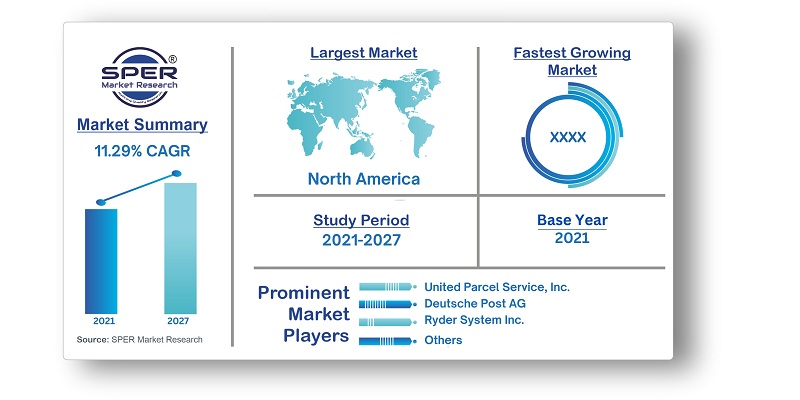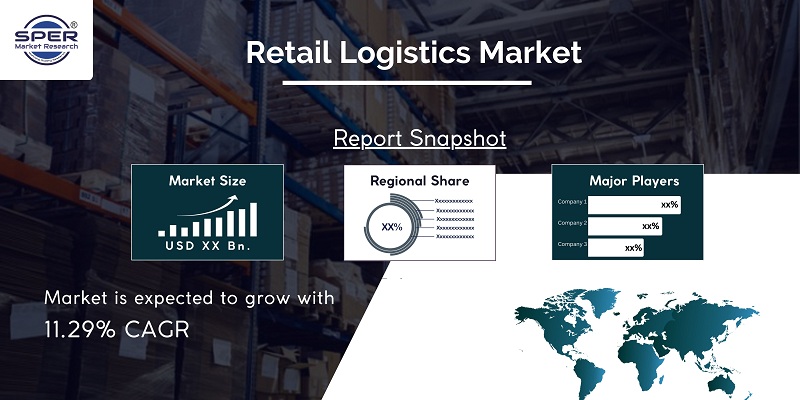
Retail Logistics Market Revenue, Trends, Share, Growth, Future Outlook
Global Retail Logistics Market by Type (Conventional Retail Logistics and E-Commerce Retail Logistics), By Solutions (Commerce enablement, Supply Chain Solutions, Reverse logistics & liquidation and Transportation Management), By Mode of Transport (Railways, Airways, Roadways and Waterways), and By Region (North America, Europe, Asia Pacific, South America, and Middle East & Africa)
| Published: Jul-2021 | Report ID: IACT2134 | Pages: 1 - 250 | Formats*: |
| Category : Information & Communications Technology | |||


1.1. Market Modelling1.2. Product Analysis1.3. Market Trend and Economic Factors Analysis1.4. Market Segmental Analysis1.5. Geographical Mapping1.6. Country Wise Segregation
2.1. Identification of Target Market2.2. Data Acquisition2.3. Refining of Data/ Data Transformations2.4. Data Validation through Primary Techniques2.5. Exploratory Data Analysis2.6. Graphical Techniques/Analysis2.7. Quantitative Techniques/Analysis2.8. Visual Result/Presentation
4.1. Economic Factor Analysis4.1.1. Drivers4.1.2. Trends4.1.3. Opportunities4.1.4. Challenges4.2. Technological Landscape4.3. Competitors & Product Analysis4.4. Regulatory Framework4.5. Company market share analysis, 20194.6. Porter’s Five forces analysis4.7. New Investment Analysis4.8. PESTEL Analysis
5.1. Market Size & Forecast, 2016-20275.1.1. Demand5.1.1.1. By Value (USD Million)5.2. Market Share & Forecast, 2016-20275.2.1. By Type5.2.1.1. Conventional Retail Logistics5.2.1.2. E-Commerce Retail Logistics5.2.2. By Solutions5.2.2.1. Commerce enablement5.2.2.2. Supply Chain Solutions5.2.2.3. Reverse logistics & liquidation5.2.2.4. Transportation Management5.2.3. By Mode of Transport5.2.3.1. Railways5.2.3.2. Airways5.2.3.3. Roadways5.2.3.4. Waterways5.2.4. By Region5.2.4.1. North America5.2.4.2. Europe5.2.4.3. Asia Pacific5.2.4.4. South America5.2.4.5. Middle East & Africa
6.1. North America Retail Logistics Market Size & Forecast, 2016-20276.1.1. Demand6.1.1.1. By Value (USD Million)6.2. North America Retail Logistics Market Share & Forecast, 2016-20276.2.1. By Type6.2.1.1. Conventional Retail Logistics6.2.1.2. E-Commerce Retail Logistics6.2.2. By Solutions6.2.2.1. Commerce enablement6.2.2.2. Supply Chain Solutions6.2.2.3. Reverse logistics & liquidation6.2.2.4. Transportation Management6.2.3. By Mode of Transport6.2.3.1. Railways6.2.3.2. Airways6.2.3.3. Roadways6.2.3.4. Waterways6.2.4. By Country6.2.4.1. US6.2.4.2. Canada6.2.4.3. Mexico6.2.5. Company Market Share (Top 3-5)6.2.6. Economic Impact Study on North America Retail Logistics Market
7.1. Europe Retail Logistics Market Size & Forecast, 2016-20277.1.1. Demand7.1.1.1. By Value (USD Million)7.2. Europe Retail Logistics Market Share & Forecast, 2016-20277.2.1. By Type7.2.1.1. Conventional Retail Logistics7.2.1.2. E-Commerce Retail Logistics7.2.2. By Solutions7.2.2.1. Commerce enablement7.2.2.2. Supply Chain Solutions7.2.2.3. Reverse logistics & liquidation7.2.2.4. Transportation Management7.2.3. By Mode of Transport7.2.3.1. Railways7.2.3.2. Airways7.2.3.3. Roadways7.2.3.4. Waterways7.2.4. By Country7.2.4.1. Germany7.2.4.2. UK7.2.4.3. France7.2.4.4. Italy7.2.4.5. Rest of Europe7.2.5. Company Market Share (Top 3-5)7.2.6. Economic Impact Study on Europe Retail Logistics Market
8.1. Asia Pacific Retail Logistics Market Size & Forecast, 2016-20278.1.1. Demand8.1.1.1. By Value (USD Million)8.2. Asia Pacific Retail Logistics Market Share & Forecast, 2016-20278.2.1. By Type8.2.1.1. Conventional Retail Logistics8.2.1.2. E-Commerce Retail Logistics8.2.2. By Solutions8.2.2.1. Commerce enablement8.2.2.2. Supply Chain Solutions8.2.2.3. Reverse logistics & liquidation8.2.2.4. Transportation Management8.2.3. By Mode of Transport8.2.3.1. Railways8.2.3.2. Airways8.2.3.3. Roadways8.2.3.4. Waterways8.2.4. By Country8.2.4.1. China8.2.4.2. India8.2.4.3. Japan8.2.4.4. Australia8.2.4.5. Rest of Asia Pacific8.2.5. Company Market Share (Top 3-5)8.2.6. Economic Impact Study on Asia Pacific Retail Logistics Market
9.1. South America Retail Logistics Market Size & Forecast, 2016-20279.1.1. Demand9.1.1.1. By Value (USD Million)9.2. South America Retail Logistics Market Share & Forecast, 2016-20279.2.1. By Type9.2.1.1. Conventional Retail Logistics9.2.1.2. E-Commerce Retail Logistics9.2.2. By Solutions9.2.2.1. Commerce enablement9.2.2.2. Supply Chain Solutions9.2.2.3. Reverse logistics & liquidation9.2.2.4. Transportation Management9.2.3. By Mode of Transport9.2.3.1. Railways9.2.3.2. Airways9.2.3.3. Roadways9.2.3.4. Waterways9.2.4. By Country9.2.4.1. Brazil9.2.4.2. Argentina9.2.4.3. Rest of South America9.2.5. Company Market Share (Top 3-5)9.2.6. Economic Impact Study on South America Retail Logistics Market
10.1. Middle East & Africa Retail Logistics Market Size & Forecast, 2016-202710.1.1. Demand10.1.1.1. By Value (USD Million)10.2. Middle East & Africa Retail Logistics Market Share & Forecast, 2016-202710.2.1. By Type10.2.1.1. Conventional Retail Logistics10.2.1.2. E-Commerce Retail Logistics10.2.2. By Solutions10.2.2.1. Commerce enablement10.2.2.2. Supply Chain Solutions10.2.2.3. Reverse logistics & liquidation10.2.2.4. Transportation Management10.2.3. By Mode of Transport10.2.3.1. Railways10.2.3.2. Airways10.2.3.3. Roadways10.2.3.4. Waterways10.2.4. By Country10.2.4.1. Saudi Arabia10.2.4.2. UAE10.2.4.3. South Africa10.2.4.4. Rest of Middle East & Africa10.2.5. Company Market Share (Top 3-5)10.2.6. Economic Impact Study on Middle East & Africa Retail Logistics Market
11.1. Company Description11.2. Financial Analysis11.3. Key Products11.4. Key Management Personnel11.5. Contact Address11.6. SWOT Analysis11.7. Company Profile11.7.1. C.H. Robinson Worldwide, Inc.11.7.2. Deutsche Post AG11.7.3. Expeditors International of Washington Inc.11.7.4. FedEx Corp.11.7.5. J.B. Hunt Transport Services Inc.11.7.6. Kuehne + Nagel International AG11.7.7. Penske Truck Leasing Co. LP11.7.8. Ryder System Inc.11.7.9. The Maersk group11.7.10. United Parcel Service, Inc.11.7.11. XPO Logistics Inc.11.7.12. Panalpina are11.7.13. Other Prominent Players
SPER Market Research’s methodology uses great emphasis on primary research to ensure that the market intelligence insights are up to date, reliable and accurate. Primary interviews are done with players involved in each phase of a supply chain to analyze the market forecasting. The secondary research method is used to help you fully understand how the future markets and the spending patterns look likes.
The report is based on in-depth qualitative and quantitative analysis of the Product Market. The quantitative analysis involves the application of various projection and sampling techniques. The qualitative analysis involves primary interviews, surveys, and vendor briefings. The data gathered as a result of these processes are validated through experts opinion. Our research methodology entails an ideal mixture of primary and secondary initiatives.



Frequently Asked Questions About This Report
PLACE AN ORDER
Year End Discount
Sample Report
Pre-Purchase Inquiry
NEED CUSTOMIZATION?
Request CustomizationCALL OR EMAIL US
100% Secure Payment






Related Reports
Our Global Clients
Our data-driven insights have influenced the strategy of 200+ reputed companies across the globe.




















